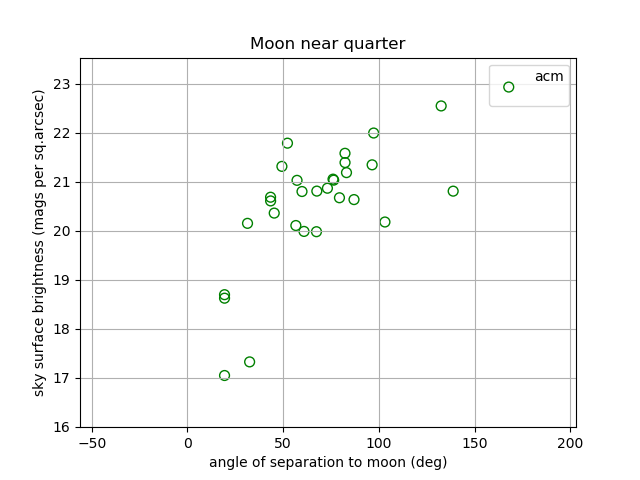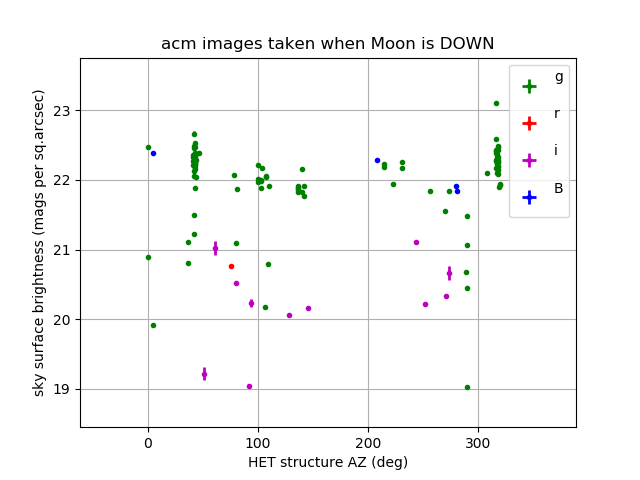Analysis 5: Reduced acm images as of June 13,2019
Last updated: June 13, 2019
As of mid Jun2019 I have reduced 174 acm images through the point of
sky surface brightness evaluation. These images are taken from 29
nights in 2018 and 2019. In addition to reducing more nights with a
moon at about 50% illumination, some of the new images use the acm B filter.
Hence, in this latest data set I have more variation in the data: another filter,
different moon conditions, some errant exposure times (EXPTIME .l1. 0.1 sec).
In this analysis I want to address the same basic questions having to do with
plotting the data:
- I want to select targets using parameter rules. For instance, I may
want to flot g data from times when the moon was down (i.e. PHIMOON=-99.0).
- I want to always plot from the original table file (A1) and use custom flag
files for each new set of points plotted.
I currently have some new tools for accomplishing goal 1 above, but goal 2 will
require some modification of my basic python plot code (pxy_SM_plot.py).
The images are in: /home/sco/acm_SBSKY (see list.05)
I do analysis in: /home/sco/scohtm/scocodes/Night_of_acm/Analysis/analysis05_jun13_2019/data
% ls -1 /home/sco/acm_SBSKY/*fits > list.05
I make a table file with fits2table. Here is the PARAMS The PARAMS file is
what determine what will be assembled i the table files.
% cat PARAMS
WAVELEN Filter wavelength (angs)
UTHOURS Hours since 0hUT
UTDATE UT date (YYYYMMDD)
RSTRT Radius position of tracker at start (mm)
AZHET HET structure AZ (deg)
MILLUM percentage moon illumination
PHIMOON angle of separation to moon (deg)
ZPSEC ZP for a 1-sec exposure
ZPERR mean error of ZPSEC
SKYSB sky surface brightness (mags per sq.arcsec)
SKYSBERR mean error of SKYSB
To get tables:
% ACM_ANALYSIS_TABLES list.05 PARAMS N
Make a nice plot:
% Generic_Points N # edit "xyplotter_auto.pars"
% xyplotter_auto A1 PHIMOON SKYSB 20 N
% xyplotter_auto A1 MILLUM PHIMOON 21 N
 |
|
A plot of acm g sky surface brightness (mss) versus the moon separation angle
in dgrees. These data were taken from the datg table file produced with a
run of ACM_ANALYSIS_TABLES. The dates of images reduced here were chose so that
the moon phase was nearly always around 40 to 60 percent illumination. A normalization
for moon phase will eventually be made so that the correlation between moon
angle and sky surface brightness should tighten up. Here I have used the datb.table file
to collect the plotted points.
|
Belwo I use the new table mask tools to plot g,r,i,B sky surface nrightness, taken
when the moon is down (PHIMOON=-99).
xyplotter_auto A1 AZHET SKYSB 30 N
To make the selections:
% table_text_mask A1 PSYSNAME g mask1 # select g observations
% table_fprange_mask A1 PHIMOON -100.0 -90.0 mask2 N # only points when moon is down
% masklogic.sh mask1 mask2 and mask3 N # make final mask
% get_table_rows A1 mask3 g_NoMoon # Make the final table file of selected data
Then I simply edit the List.30 file to add this set.
% xyplotter List.30 Axes.30 N # view the full plot
To do the 4 filters separately:
% table_fprange_mask A1 PHIMOON -100.0 -90.0 mask2 N
Collect g data:
table_text_mask A1 PSYSNAME g mask1
masklogic.sh mask1 mask2 and mask3 N
get_table_rows A1 mask3 g_NoMoon
Collect i data:
table_text_mask A1 PSYSNAME i mask1
masklogic.sh mask1 mask2 and mask3 N
get_table_rows A1 mask3 i_NoMoon
Collect r data:
table_text_mask A1 PSYSNAME r mask1
masklogic.sh mask1 mask2 and mask3 N
get_table_rows A1 mask3 r_NoMoon
Collect B data:
table_text_mask A1 PSYSNAME B mask1
masklogic.sh mask1 mask2 and mask3 N
get_table_rows A1 mask3 B_NoMoon
Make the plot: xyplotter List.30 Axes.30 N
Using the above procedure, I built the plot below for the 4 filters
available when mookless, clear conditions were present.
 |
|
A plotbrated sky surface brightness in gmrmi,B measure from images taken under
moonless and clear conditions. These acm images are taken from 29 nights in 2018
and 2019. The photometrc zeropints were calbrated using PANSTARRS photometry, after
WCS calibration was performed with the USNOB-1.0 catalog. No attempt has been made to
clean discrepant points. It was discovered that some image with extremely short exposure
time still remain in this data set.
|
Back to top analysis page

